Mycenaean Greek ornate agate sword, 1400 BC
In contrast to Anatolia and Near East, the earliest stages in the development of Mediterranean metallurgy appear only after about 5500 BC. During the late Neolithic of Aegean (ca. 5500-4500 BC) pins of copper turn up at Dikili Tash, Paradeissos, and Kitsos Cave, while two small daggers have been recovered from Aya Marina in Phocis. It was only during the following, Final Neolithic period (ca. 4500-3700 BC) however that Aegean metallurgy began to flourish. Copper, Gold, silver and lead artifacts have been recovered at least twelve different sites of this period, including large assemblages of metal finds at sites such as Zas Cave on Naxos and copper daggers from Dimini and Sesklo. The early swords of the Aegean Bronze Age are some of the most striking artefacts from this epoch in terms of craftsmanship and opulence. Their perceived role has at various times ranged from their being ritual objects, to being restricted in terms of modes and environments of use, to their being perfectly serviceable tools of war. The early swords evolving out of the dagger. Before bronze, stone was used as primary material for cutting edged tools and weapons. Stone is however very fragile, and therefore not practical to be used as swords. With the introduction of copper, and eventually bronze the daggers could be made longer, and evolved into swords. The earliest Aegean/Anatolian swords were found at Arslantepe, Turkey, dating to ca. 3300 BC. Sword finds are however very rare until around 2300 BC. In general, the evolution of blade weapons in the Aegean Bronze Age is from the dagger or knife in the Early Bronze Age to the earliest narrow bladed “rapier” swords optimized for thrusting from the Middle Bronze Age to the typical leaf-shape blades in the Late Bronze Age.EARLY SWORDSOne of the earliest sword attested in the Aegean area is this copper specimen from Naxos dated around 2800-2300 BC. Its design is similar to the early type of Aegean dagger. The length of this sword is 35.6 cm

Cycladic copper sword from Amorgos. The length of this sword is 59 cm.Very interesting bronze leaf-shaped sword dated EC II (about 2800-2300 BC) from the Cycladic island of Amorgos. On this very primitive bronze manufacture some traces of tin are still visible on the balde.

 Cycladic copper sword from Naxos dated around 2500 BC. The length of this sword is 35 cm.Typical Cycladic copper sword dated around 2300 BC
Cycladic copper sword from Naxos dated around 2500 BC. The length of this sword is 35 cm.Typical Cycladic copper sword dated around 2300 BC

These kind of early leaf-shaped swords or daggers were attached to a baldric as attested from this marble statue of an hunter/warrior dated around 2300 BC from the Cyclad island of Naxos. Very interesting the incised ornamentation of the baldric.
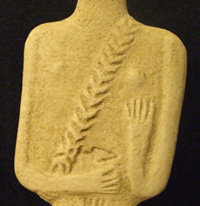
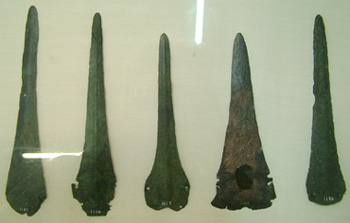
Group of Minoan bronze short swords from Iraklion and Ziba. The general design of these weapons clearly evolved from the early leaf-shaped Aegean daggersAnother interesting example of bronze short sword from Aghia Triada crete dated around 1600 BC. These kind of short swords can be also interpreted as daggers

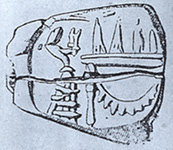
One of the early possible representation of Minoan short swords is on a seal from Haghia Triada Crete dated around MM III- LM I (about 1600 BC). In this cult scene some swords and dagger blades seems to be placed with points upward on the altar.Some medium size early minoan swords are also represented on a cup dated around 1700-1550 BC.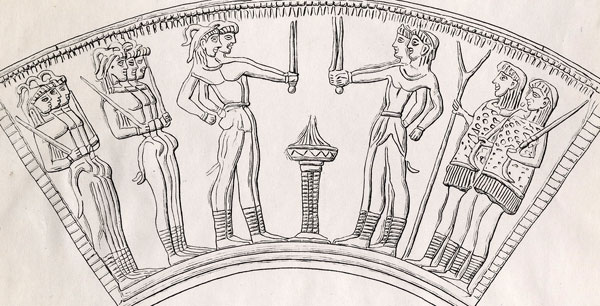
One of the most interesting inventions of the Aegean Bronze Age was the great sword. The weapons which appeared towards the middle of the second millennium BC in Crete and mainland Greece differ from all the previously swords in the combination of length of blade, strength of midrib and, in one type, the use of flanges for hafting, on tang or shoulder. The analysis of some specimens shows that the material is an alloy of copper and tin or arsenic for making the bronze. When the percentage of copper or tin content is high the bronze blades have a reddish or silver color respectively. Whether this was made intentionally to imitate costly metals like gold and silver and to give these swords or daggers a better and more valuable appearance, or was simply the result of mis-calculation of the right quantities of alloy it is not possible to guess.The Bronze Age swords findings in Greece occurred in the last years and the most recent publications have confirmed the evolutionary process and the swords classification introduced by Sandars. The Sandars‘s classification catalogue the various type of Greek Bronze Age swords in eight main groups identified from the letter A to H.
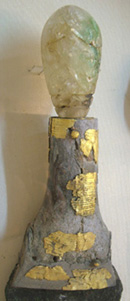

A link between the Minoan triangular small swords or daggers and the long A Type sword can be represented by the specimen found in Mallia Crete dated around 1700 BC. This sword shows a large and long blade with a large and flat midrib. On its rounded upper part four rivet holes are used to attach the blade to its decorated hilt and two rivets holes are present on the tang.
The awesome part of this sword is represented by its hilt which was covered with a gold engraved plate and on its extremity a marvellous crystal rock was installed.A sword with a similar blade with large flat midrib is probably the one represented in the egyptian fresco in the tomb of Rekhmire in Thebes where Cretan tribute-bearers are shown.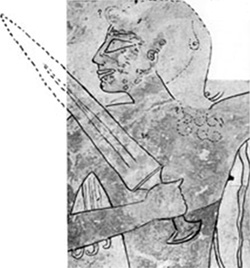
 Other examples of Cretan long bronze swords, which could be interpreted as ancestors of the A Type and B Type swords, are attested from the palace of Zakros.Similar long early thrusting swords are also attested from Arkalochori.
Other examples of Cretan long bronze swords, which could be interpreted as ancestors of the A Type and B Type swords, are attested from the palace of Zakros.Similar long early thrusting swords are also attested from Arkalochori.
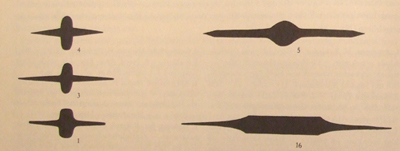 Some typical cross section of Cycladic and Minoan sword:
Some typical cross section of Cycladic and Minoan sword:
1) Sword from Amorgos, 3) sword from Amorgos, 4) Sword from Mesaria, 5) Sword from Apeiranthos, 16) Sword from MalliaA Type
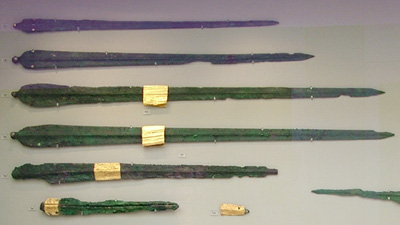 The earliest of the Aegean long swords come from the palace of Mallia in Crete, and the shaft-graves of Mycenae (*1). Furthermore specimens of the Type A swords are also attested in the Cycladic islands, in the Ionian islands and in Central Europe. These swords are sometimes a metre long; they have flat narrow tangs, either very short with one rivet hole, or longer with two or three. The shoulder is rounded and un-flanged, and two rivets are placed in the upper part of the blade about 3 cm under the shoulder. There is a high midrib usually of rhomboid section, but occasionally rounded, always abrupt, except in some cases when it carries an elaborate decoration.The grip of these swords was made of wood or ivory sometimes decorated with gold applications. The hand-grip was completed by a knob which also in this case could have been made of wood, ivory, amber or gold. It was worked separately and than applied on the dedicated extension of the tang. The swords A type are dated from the MM II-III (about 1700-1600 BC) to the LM/LH I-II (about 1600-1500) and the most recent specimens to the LH IIIA (about 1400 BC)
The earliest of the Aegean long swords come from the palace of Mallia in Crete, and the shaft-graves of Mycenae (*1). Furthermore specimens of the Type A swords are also attested in the Cycladic islands, in the Ionian islands and in Central Europe. These swords are sometimes a metre long; they have flat narrow tangs, either very short with one rivet hole, or longer with two or three. The shoulder is rounded and un-flanged, and two rivets are placed in the upper part of the blade about 3 cm under the shoulder. There is a high midrib usually of rhomboid section, but occasionally rounded, always abrupt, except in some cases when it carries an elaborate decoration.The grip of these swords was made of wood or ivory sometimes decorated with gold applications. The hand-grip was completed by a knob which also in this case could have been made of wood, ivory, amber or gold. It was worked separately and than applied on the dedicated extension of the tang. The swords A type are dated from the MM II-III (about 1700-1600 BC) to the LM/LH I-II (about 1600-1500) and the most recent specimens to the LH IIIA (about 1400 BC)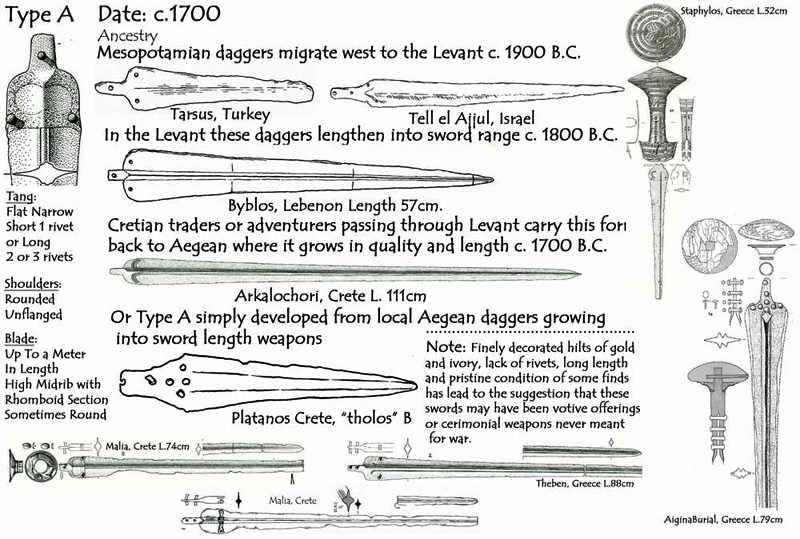 A very usefull summary table of the Achaean A Type swords has been made by Professor Kirk Spencer from the Sword Forum International
A very usefull summary table of the Achaean A Type swords has been made by Professor Kirk Spencer from the Sword Forum International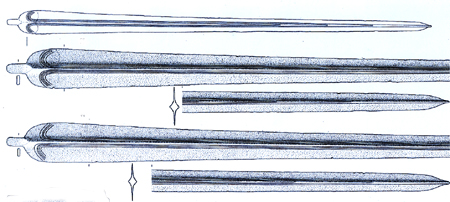 Some of the earliest A type bronze swords dated about 1700 BC from Arkalochori Crete. The length of these sword is respectively 111 cm and 105.5 cmOne of the earliest A type bronze swords dated about 1700 BC is attested from Aegina island. In This interesting specimen the tang and the shoulders show eight rivets for the fixation of the hand-grip and one rivet on the top of the tang used for the upper knob. This sword is 79.1 cm long.
Some of the earliest A type bronze swords dated about 1700 BC from Arkalochori Crete. The length of these sword is respectively 111 cm and 105.5 cmOne of the earliest A type bronze swords dated about 1700 BC is attested from Aegina island. In This interesting specimen the tang and the shoulders show eight rivets for the fixation of the hand-grip and one rivet on the top of the tang used for the upper knob. This sword is 79.1 cm long.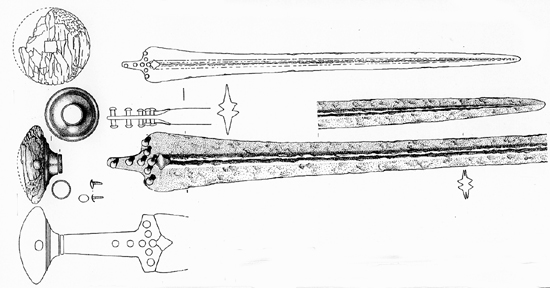
 Other early examples of A type sword are attested in Crete like this bronze sword from Mallia dated around 1700 BC. In the same excavation an Ivory knob was also found.Other very well preserved examples of Cretan A type bronze swords from the palace of Zakros.
Other early examples of A type sword are attested in Crete like this bronze sword from Mallia dated around 1700 BC. In the same excavation an Ivory knob was also found.Other very well preserved examples of Cretan A type bronze swords from the palace of Zakros.
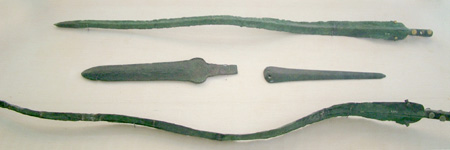 From the same palace of Zakros several specimen of A type swords dated around 1700-1600 BC are attested.A type sword from Thebes dated around MH III- LH I (about 1600 BC.). The length of this sword is 87.7 cm
From the same palace of Zakros several specimen of A type swords dated around 1700-1600 BC are attested.A type sword from Thebes dated around MH III- LH I (about 1600 BC.). The length of this sword is 87.7 cm
 A type swords from Mallia with a gold decorated knob. This specimen is 74.1 cm long
A type swords from Mallia with a gold decorated knob. This specimen is 74.1 cm long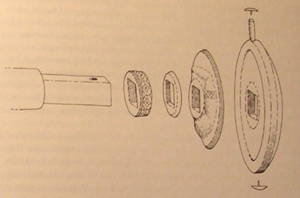 General assembly of the elements composing the knob of the above mentioned A type swords from MalliaA type swords are also attested from the shaft graves of the cirle B from Mycenae dated around 1600 BC.
General assembly of the elements composing the knob of the above mentioned A type swords from MalliaA type swords are also attested from the shaft graves of the cirle B from Mycenae dated around 1600 BC.
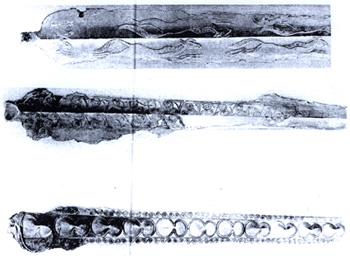 Several A Type bronze swords are also attested from the shaft-graves of the circle A in Mycenae dated LH I-LHII (about 1550-1500 BC). Some of these swords found by Henry Schliemann in the graves IV and V show very beautiful blade decorations representing running horses, shields in figure of eight and spirales.
Several A Type bronze swords are also attested from the shaft-graves of the circle A in Mycenae dated LH I-LHII (about 1550-1500 BC). Some of these swords found by Henry Schliemann in the graves IV and V show very beautiful blade decorations representing running horses, shields in figure of eight and spirales.
Related Post
A shocking documentary proves that mermaids do exist
SHOCKING Revelation: Thuya, Mother of Queen Tiye, Was the Grandmother of Akhenaten and Tutankhamun—What Ancient Egyptian Secrets Did She Leave Behind?
Breaking News: Astonishing Discoveries at Karahan Tepe Confirm an Extraterrestrial Civilization is Hiding on Earth, and NO ONE Knows!
Breaking News: Researchers FINALLY Discover U.S. Navy Flight 19 After 75 Years Lost in the Bermuda Triangle!
NASA’s Secret Investigation: Uncovering the Astonishing Mystery of the UFO Crash on the Mountain!
Explosive UFO Docs LEAKED: Startling Proof That Aliens Ruled Ancient Egypt!